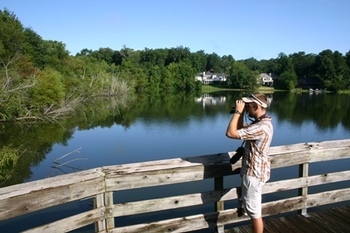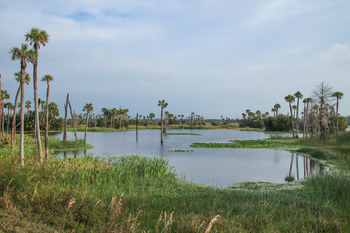 Great Florida Birding and Wildlife Trail Sign
When you see a Great Florida Birding and Wildlife Trail sign, what do
you think about? Is it something you recognize easily or don’t notice as you
are driving down a country road? With about 1,500 GFBWT signs scattered
throughout Florida, you probably have encountered one while driving through the
state. But what do these signs represent?
To me, when I see one of these signs, I think of the adventures to
come. In my short time in Florida, I have visited over 60 birding trail sites
and enjoyed every minute of it. Each birding trail site is different. From Fort
Zachary Taylor Historic State Park in Key West that has white-crowned
pigeons flying around and attracts a variety of migrating birds to Huguenot
Memorial Park in Jacksonville that hosts a breeding royal tern colony.
No matter where you are, there’s a birding trail site with something amazing to
observe.
But how do sites become part of the birding trail? A nomination period
is opened every few years, and anyone can submit a site for consideration. The
nominated sites then are surveyed by birding trail staff and volunteers for
their birds, wildlife and amenities. This is done to be sure we add only the
best sites for wildlife viewing and visitor experiences to the birding trail.
So, when you see those brown and white signs as you are riding around
Florida, you should know now what they represent: a nearby place to go wildlife
watching and a great place to explore. If you just follow the arrows and open
yourself to nature, you undoubtedly will have an incredible experience!
 Birder
Every hobby and activity has its own terminology or jargon. Birding is
no different. Out in the field you may hear terms like “twitching,” “dipped”
and “vagrants.” Here are a few commonly used birding terms that should make you
sound like an avian pro!
Lifer (noun): the first time
a bird species has been seen by a birder.
Spark bird (noun): a bird
species that sparked the someone’s interest in birding.
- Example: My spark bird was a red-winged
blackbird because it was the first one that I knew the name of.
Dipped (verb): missing out on
a bird you are seeking.
- Example: I spent the
weekend at A. D. Barnes Park looking for the Townsend’s warbler,
but I dipped!
 Short-tailed Hawk
Many people experience great joy watching hawks and eagles soar in the
thermals. Short-tailed
hawks are a particularly exciting hawk to observe but can be difficult to
find. They fly high to get a good vantage point and not spook their prey as
they search for and feed on small birds.
Short-tailed hawks are small tropical hawks considered “very uncommon”
in Florida. Yet this is the only state that has consistent sightings of these
hawks year-round. They have two distinct color phases: light and dark. These
coloration differences are not indicative of gender, and they will interbreed.
Look for these hawks in pines, wood edges, cypress
swamps and mangroves.
They prefer habitats near open country next to woodlands. Short-tailed hawks
rarely perch in the open and are usually seen soaring up high. There are lots
of good places along the GFBWT to spot these hawks, including: Fort
De Soto Park, Corkscrew
Swamp Sanctuary, Deering
Estate, Frog
Pond WMA – Lucky Hammock and Paynes
Prairie Preserve State Park.

The Orlando Wetlands
Park is in the east section of the Birding Trail. It is in the town of Christmas,
Florida, outside of Orlando in Orange County. With over 220 bird species and 63
butterfly species at this park, it is a “must visit” for birders and wildlife
viewers.
This park is an unusual birding location as it is primarily a wastewater treatment
wetland. The aquatic plants in the wetlands are the last filtration step
before the water is discharged into the St. Johns River. This provides the
perfect habitat for a variety of birds, which can be viewed from exposed dikes
that form the trails. There are approximately 1,200 acres of this man-made
wetland.
The park is open daily from sunrise to sunset and does not require a
fee. On Fridays and Saturdays, Friends of the Orlando Wetlands offers tram
tours from 9 a.m. – 3 p.m. This is a great way to see the park and have a
vantage point from which to spot alligators and wading birds. Guests also may
walk the dikes and a couple of trails to explore the park at their own pace.
Some amazing species that can be sighted here include: snail kite,
limpkin, black-bellied
whistling-duck and many more. In the summer, you may see lots of purple
gallinule chicks foraging alongside their parents in the impoundments and
speckled juvenile white
ibis feeding in the shallows.
The Orlando Wetlands Park is not to be missed if you are in the area.
Make sure to take the tram tour if you visit on the appropriate days. Take
plenty of water and bug repellent, wear comfortable shoes and grab a trail map.
You will be set for a great day of exploring!
Site Address: 25155 Wheeler Road, Christmas, Florida 32709
Contact: (407) 568-1706
Site Hours, Daily: sunrise to sunset
Check out the eBird list
for this park.
October 11-14 – Florida
Birding and Nature Festival (Tampa, FL)
October 11 – Shorebird
Walks at Matanzas Inlet (St. Augustine, FL)
October 12-14 – Festival
of Flight and Flowers (Eustis, FL)
October 12 – Washington
Oaks Gardens State Park (Palm Coast, FL)
October 12 – Preschoolers
in the Park (Ponce Inlet, FL)
October 13 – Largo
Central Park Nature Preserve (Largo, FL)
October 13 – Bayard
Conservation Area Field Trip (Green Cove Springs, FL)
October 13 – San
Felasco Hammock (Millhopper) Bird Walk (Gainesville, FL)
October 13 – Explore
the Outdoors Festival (Freeport, FL)
October 14-20 – “Ding”
Darling Days (Sanibel, FL)
October 14 – Bolen
Bluff Trail Bird Walk (Micanopy, FL)
These are just a few events listed on our calendar. Check out the event page for more!
Do you know about other bird or wildlife-related events going on in
Florida? Help spread the word by letting us know! Send in the times, dates,
locations and contacts to Savanna.Christy@MyFWC.com
for posting on the GFBWT website.
Events must be related to birds or other wildlife and open to the
public. Examples include interpretive programming, summer camps and family
programs.
|